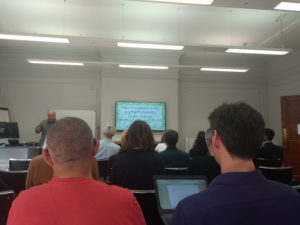It was another sell-out crowd for our 5th Digital Research Conversation, held on 10th September, where our five speakers discussed Virtual Reality (VR), Augmented Reality (AR) and data visualisation.
Augmented Reality is where a real-world environment is enhanced with computer-generated information such as digital images, projections and holograms eg. Pokemon GO. Virtual Reality is where the viewer is closed off to a completely computer-generated environment. Both allow the user to interact with the simulated environment. With the increasing amounts of ‘big data’ now created in research, we face challenges in how to store, analyse and visualise the data. Data Scientists apply models to extract the relevant information from large data sets but virtual and augmented reality are changing the way we interact with and interpret data.
 After some refreshments, we started off with our first speaker, Dr Phil Murgatroyd, who is Project and Modelling Manager of Europe’s Lost Frontiers at the University of Bradford. Phil discussed data visualisation and augmented reality under the sea. Phil has seismic data which is very large (100’s of GB’s) and data from cores taken through the seabed and needs to combine the two large datasets in order to simulate past sea-levels. Augmented reality headsets allow him to visualise the landscape and view changes over time eg. 100 years later. We were able to see an example where deer are roaming around on what would now be land that is under the sea. Using augmented reality has helped with public engagement around the project.
After some refreshments, we started off with our first speaker, Dr Phil Murgatroyd, who is Project and Modelling Manager of Europe’s Lost Frontiers at the University of Bradford. Phil discussed data visualisation and augmented reality under the sea. Phil has seismic data which is very large (100’s of GB’s) and data from cores taken through the seabed and needs to combine the two large datasets in order to simulate past sea-levels. Augmented reality headsets allow him to visualise the landscape and view changes over time eg. 100 years later. We were able to see an example where deer are roaming around on what would now be land that is under the sea. Using augmented reality has helped with public engagement around the project.
We then went on to hear from Victoria Williams (PhD researcher, English Literature) who is researching the way we interact with immersive virtual environments and how it affects us. Victoria took us back to the start of virtual reality with Heilig’s Sensorama (1962) and the Virtual Boy Nintendo (1995) and then discussed the emerging technologies, such as being able to view the world as a bat and covering a headset in grass so that the experience is more natural. There is a demand for transparent technology where there is no interface, however immersions in virtual reality can lead to disorientation, so user feedback is important. We also need to consider what ethical implications there may be to using virtual reality. You can find out more on this area by attending the PLAY/PAUSE seminar series – follow @PLAYPAUSE_UOB on Twitter.
 Moving back to look at visualising data, Dr Biao Cai from the School of Metallurgy and Materials discussed his research, which involves visualising crystal growth in 4D. Super metal alloys are formed from crystal growth (just like icecream is) and they can be visualised forming in their pretty patterns by combining time and X-ray tomography data. Biao is interested in looking at the effects of gravity on crystal growth as this would be important if we start manufacturing metals for use on other planets in the future.
Moving back to look at visualising data, Dr Biao Cai from the School of Metallurgy and Materials discussed his research, which involves visualising crystal growth in 4D. Super metal alloys are formed from crystal growth (just like icecream is) and they can be visualised forming in their pretty patterns by combining time and X-ray tomography data. Biao is interested in looking at the effects of gravity on crystal growth as this would be important if we start manufacturing metals for use on other planets in the future.
Dr Richard Graham (Lecturer in English Literature) then took us back to virtual reality, discussing how we can teach it in the Humanities field. Virtual Reality can be used to create virtual tourism where we can visit places and have experiences through a headset. An example is theBlu: Whale Encounter where you can experience swimming underwater with a whale. How someone reacts to a virtual reality environment can be difficult to explain to others, hence students need to have a first-hand experience of the technology. However, it is possible to look at how people physically respond to VR by looking at responses such as eye movement and heart rate.
Finally, we returned to look at historical data with Professor Henry Chapman from Archaeology. Henry studies human behaviour in the prehistoric period and makes use of data visualisation to study different spacial, time and resolution data. Henry’s group has used 3D high-resolution sensing of Stonehenge to discover lots of new burial sites hidden below the landscape in the Stonehenge Hidden Landscapes Project.
Data visualisation, VR and AR are important in many different research fields as illustrated by the diverse field of speakers that presented. With the increasing use of these technologies, we need to be thinking of how we archive 3D data for future access and re-use. Where do we store such large amounts of data? Visualisation of geophysical data involves high-resolution images over several layers. How will it be accessed/interacted with? If you would like to contribute to the discussion then please comment below.
Our 6th Digital Research Conversation is currently being planned for April which will be on the topic of ‘how far do you trust data and data analysis’? See our blog post here for more information and do contact us if you are interested in speaking on the topic (email us at bearinfo@contacts.bham.ac.uk).
